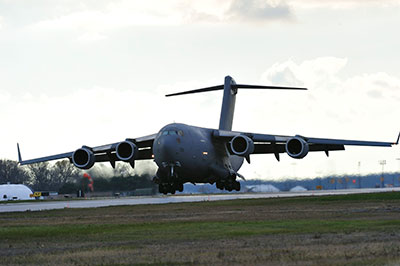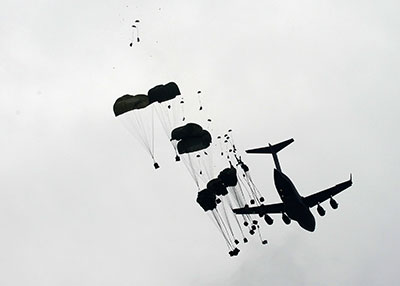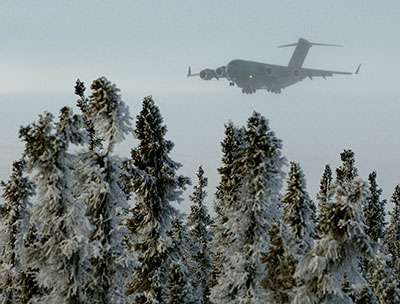Commentary

DND photo IS2012-6016-061 by Sergeant Gaétan Racine
A Canadian Armed Forces CC-177 (C-17A) aircraft from 429 Transport Squadron is about to touch down during a training flight in the Trenton area, 15 November 2012.
How much Strategic Airlift is enough?
by Martin Shadwick
For more information on accessing this file, please visit our help page.
In a fiscal environment so tight that the expansion of the RCAF’s Twin Otter fleet from four to five aircraft would be problematic, the quest in some quarters for a fifth C-17A Globemaster III—a decidedly more expensive proposition than the humble Twin Otter—will strike some observers as a quixotic ‘non-starter.’ If one considers the ramifications for strategic airlift of ending Canada’s major combat role in Afghanistan (a role that figured prominently in the raison d’etre of the current C-17A fleet), the looming termination of Canada’s training role in Afghanistan, and the decidedly modest number of Canadian military personnel presently deployed on United Nations peacekeeping and peace support operations and then adds the reservations of those who favour other procurement priorities, who harbour doubts about the C-17A’s ability to operate from short runways and austere airfields, or who are wary of the political optics of media imagery showing C-17As disgorging armoured limousines and SUVs during prime ministerial visits, then the case for a fifth C-17A may well sink below the ‘non-starter’ level. That said, it would be both imprudent and short-sighted to reject out of hand the augmentation of the existing C-17A fleet. The current fleet has performed yeoman service across a broad spectrum of non-military, quasi-military, and military roles, both at home and abroad, since the first aircraft was delivered to CFB Trenton in 2007, but fleets as tiny as four aircraft can pose a complex array of serviceability, availability, and cost-effectiveness issues. Canada may well find, upon closer inspection, that the experience of other C-17A operators, who initially acquired four aircraft, but then incrementally expanded their fleets—to eight in the case of the Royal Air Force and six in the case of the Royal Australian Air Force—would be worth emulating.
Having fumbled the acquisition of an earlier strategic airlifter—the Lockheed C-141A Starlifter—in the late-1960s, and then witnessed a distinct lack of enthusiasm for Canadian-owned (as distinct from pooled) strategic airlifters during the Jean Chrétien and Paul Martin eras, it is something of a miracle that Canada even acquired the C-17A. Liberal defence minister John McCallum, for example, informed the 2003 annual general meeting of the Conference of Defence Associations that “… the Canadian Forces will not be unilaterally purchasing large transport planes.” In November 2002 and April 2003, testifying before the Standing Committee on National Defence and Veterans Affairs (SCONDVA), McCallum took note of the substantial financial cost of strategic airlifters such as the C-17A, expressed concern over the perceived paucity of gainful employment for such aircraft in normal day-to-day (i.e., non-surge) operations, and observed that only two NATO members, the United States and the United Kingdom, possessed their own strategic airlifters. While acknowledging that strategic airlift was “a high priority,” McCallum argued that some form of pooling arrangement with NATO allies constituted the way forward. The lack of enthusiasm for a Canadian C-17A fleet was not confined to the political level. Rick Hillier, both before, and—at least initially—after his appointment as Chief of the Defence Staff, staunchly opposed acquisition of the C-17A, while championing the recapitalization of Canada’s tactical airlift (i.e., C-130 Hercules) capability.
It took the arrival of Stephen Harper’s Conservative government, and, in particular, the pivotal efforts of his first minister of national defence, Gordon O’Connor, to secure C-17As for the Canadian Armed Forces. The new government argued that “today’s changing and uncertain global environment demands Canada’s military have its own reliable and independent access to strategic airlift to move heavy equipment quickly, over long distances and deliver it to where it is needed in Canada, in support of humanitarian relief, or to a theatre of operations.” Ottawa’s decision to acquire only four aircraft—internal air force studies had indicated a requirement for five or, preferably, six aircraft—was a reflection of hard-fought trade-offs, and, as such, something of a disappointment, but the core decision to eschew pooling in favour of a Canadian C-17A fleet was both prudent and pragmatic, given the inherent flexibility of strategic airlifters, the vagaries and risks of total dependence upon pooling, chartering or borrowing, and the unpredictable and unforgiving post-Cold War and post-9/11 strategic environment. It should, of course, be noted that acquisition of four C-17As did not totally eliminate the need to charter foreign airlift resources.
The decision to procure the C-17A, announced in June 2006 as part of a larger $17.1 billion mobility and logistical package that included three multi-role Joint Support Ships, a “… minimum” of sixteen medium-to-heavy-lift transport helicopters (i.e., a variant of the Boeing CH-47F Chinook), 17 tactical transport aircraft (ultimately the Lockheed C-130J Hercules), and 2300 medium logistics trucks, generated some criticism related to the modalities of the procurement process (i.e., the use of the Advance Contract Award Notice (ACAN) mechanism, and the exclusion of the C-17A project, on ‘national security’ grounds, from the provisions of the North American Free Trade Agreement, the World Trade Organization—Agreement on Government Procurement, and the Agreement on Internal Trade), but the C-17A purchase per se attracted virtually no political, public or media backlash. Indeed, with the benefit of hindsight, a fifth C-17A should have been pursued vigorously in 2006-2007 when the economy was comparatively healthy, when public support for defence modernization was comparatively robust, and the needs of the Afghanistan operation loomed large.

DND photo IS2013-1015-04 by Sergeant Matthew McGregor
A Canadian CC-177 completes a heavy equipment drop as part of the Joint Operational Access Exercise 13 (JOAX 13) held at Fort Bragg, North Carolina, 22 February 2013.
In a January 2013, position paper that “strongly” recommended the acquisition of “at least one” additional C-17A for the RCAF “as soon as possible”, the Air Force Association of Canada (AFAC) lauded both the C-17A’s “… ability to operate into and out of short runways and austere airfields” and its usefulness since entering service: “In just five years, the [C-17A] has enabled the Government of Canada to respond to a wide array of domestic and global humanitarian missions and expeditionary operations. Domestically, annual support to Op Nanook in the Arctic, and the re-supply of [Canadian Forces Station] Alert are prime examples of the aircraft’s capabilities. Internationally, the humanitarian relief mission to Haiti, the air bridge between Canada and Afghanistan, and the rapid transfer of support equipment to the Libyan campaign, clearly demonstrate the aircraft’s unique expeditionary capabilities. In fact, it was these attributes that enabled the Government to respond in Haiti and Libya within the first few hours of these crises...”
The position paper noted that some of the maintenance and support issues traditionally associated with small fleets had been mitigated by joining the C-17 “Globemaster Integrated Sustainment Program (GISP), which allows certain support costs associated with the aircraft to be apportioned on a pro-rata basis across all users… A requisite of the GISP program, however, is that all aircraft in the global fleet must be maintained and upgraded to a common standard, requiring that they undergo a ‘heavy maintenance’ program approximately once every five years. This process takes about five months to complete, and, given the heavy utilization of Canada’s [C-17A] fleet over the past five years, all four of our aircraft will have to go through the program during the next two years. What this means in practical terms is that the [ambitious] tasking rate the RCAF has maintained in the past will not be attainable over the next two years—and this same situation will present itself every four-to-five years thereafter. In other words, Canada will face periods where the availability of strategic air mobility will be severely curtailed, and the CAF’s ability to respond to a crisis potentially jeopardized.” The paper acknowledged that the ’operational pause’ “…the Canadian Forces are now experiencing may partially offset the near-term pressure on the [C-17A] fleet,” but cautioned that “…no one can predict when or where the next humanitarian disaster or global crisis will occur.”
The AFAC paper posited that an additional C-17A would allow Ottawa to “avoid or reduce appreciably the requirement to use contracted offshore airlift resources to support CF operations, resulting in significant annual savings which could be used to offset acquisition costs associated with an extra aircraft,” adding that “…the need for contracted airlift may be especially acute should unforecasted demands occur during…heavy maintenance” periods. Moreover, an additional C-17A “… would increase the number of aircraft available for tasking by about 25 [percent] and also allow the RCAF to spread utilization over a larger fleet. This would provide the Government with an enhanced ability to respond to domestic and international crises, support its evolving strategy for exercising sovereignty over the lands and waters in Canada’s vast northern areas and reduce the costs associated with contracted airlift.”
Decidedly less than enthralled with the AFAC’s case for a fifth C-17A was Stephen Priestley of the online Canadian American Strategic Review (CASR). “The Air Force Association of Canada,” he writes, “now advocates us buying another C-17. The main reason stated is that the first go-around contract leaves us an aircraft short when the mandatory maintenance bell dings (well, we don’t want to void that add-on warranty, do we?). Nor do we want to be caught short on the [C-17’s] capabilities—which AFAC starts by praising but that former C-17 Project Management Office staffers now say never existed.” One aim “… of DND’s Airlift Capability Project (Strategic) was to garner a rough-field capability not available with leased airlifters while, at the same time, giving complete control over these new assets. Well, it seems that the C-17 Globemaster Integrated Sustainment Program ensures that our control is limited.”
“Before we’re on the hook” for another C-17A, argues Priestley, “would the Airpower Advocacy Committee [of the AFAC] care to [tote] up how many billions we’ve spent so far” for the in-service support maintenance contract, dedicated C-17A ground support equipment, new hangars, and upgrades to runways, taxiways and parking pans?” “To be fair,” writes Priestley, “the Air Force Association of Canada openly acknowledges that Boeing is one of its sponsors… Nor is there any hint that the Airpower Advisory Committee writers unfairly favour one of its sponsors. No, it is more that AFAC has never met an expensive Air Force procurement project that it didn’t like.”
Arguably shrill, and not altogether representative of the CASR’s more customary blend of bluntness and constructive criticism, the CASR rebuttal can, in turn, be challenged on a number of points. C-17A infrastructure costs, notably at CFB Trenton, have most assuredly been substantial, but could one not argue that sunk costs actually bolster the case for a fifth C-17A? The CASR raises an interesting point when it characterizes the C-17 Globemaster Integrated Sustainment Program as sovereignty-eroding but was there a credible and cost-effective alternative? The CASR’s reservations about the rough-field capability of the C-17A will undoubtedly raise hackles, but, in fairness, the issue is not new. As the British aviation journal AIR International recently observed, “a debate has raged for years in the [United States Air Force] C-17 community about when, whether, how much and exactly how the C-17 should operate from unpaved runways.” The CASR’s contention that the rough-field capability of the C-17A was oversold in the Canadian context deserves wider analysis, but there can be no denying that the C-17As bring new and impressive capabilities in this area. Other points of disagreement between the AFAC and CASR can, one trusts, be resolved without recourse to ‘blue berets.’
DND photo IS2013-1015-04 by Sergeant Matthew McGregor
Enroute in a Canadian Globemaster III over Algiers, Algeria, 1 February 2013.
Can a credible case be made for the judicious expansion of Canada’s C-17A fleet? Those responding in the affirmative would stress that strategic airlift is, by definition, a highly flexible enabler and force multiplier, one that generates additional options for Ottawa decision-makers, and one that is relevant to all branches of the Canadian Armed Forces, to the full spectrum of non-military, quasi-military, and military roles, and to domestic, regional, and overseas operations. More to the point, an additional C-17A would: (a) materially boost Canada’s strategic airlift capability and significantly enhance availability and lines of tasking; (b) provide valuable capacity when a C-17A is absent for heavy maintenance; (c) avoid or diminish appreciably the need to charter commercial aircraft or rely on the strategic airlift resources of allies; (d) maximize the return on investment already made in the existing C-17A fleet and infrastructure; (e) extend the service life of the C-17A fleet; and (f) provide an additional hedge against unforeseen contingencies.
Those less enamored of follow-on C-17A procurement may well, in fact, acknowledge the multifaceted versatility of strategic airlift, but posit that the cost of additional procurement (and any necessary additional military personnel) is simply too high, given exceedingly tough economic times and a host of competing military priorities. In an echo of John McCallum’s comments of a decade ago, there are also lingering doubts in some quarters about the day-to-day need for more than four strategic airlifters. The Canadian strategic airlift fleet may not be perfectly sized, but it is “right-sized,” and, supported by chartered or borrowed foreign aircraft, a new fleet of C-130Js, and, in due course, a new fleet of Fixed-Wing Search and Rescue (FWSAR) aircraft with secondary or tertiary airlift capabilities, should suffice.
DND photo IS2013-6256-01 by Corporal Melissa Spence
Members of the French Army disembark a Royal Canadian Air Force CC-177 Globemaster III aircraft in Bamako, Mali, 26 January 2013.
Official comment on the prospects for an additional C-17A has been limited. When queried on this issue by Canadian Defence Review, the Chief of the Defence Staff, General Tom Lawson, observed that “… the Department briefly considered exploring options to purchase a fifth [C-17A]. As the option was explored further, it was determined that it was currently not affordable and has been put on indefinite hold.” Lawson’s comments were diplomatic and carefully nuanced, but, with C-17A production finally nearing its end—and no credible prospect of significant, or even modest, new orders from the United States—the question of a fifth new-build Canadian C-17A will soon become academic. If Canada desires that fifth aircraft, if it wishes to possess an additional measure of strategic airlift insurance—and prudence suggests that it should—it must move expeditiously.
Martin Shadwick teaches Canadian defence policy at York University. He is a former editor of Canadian Defence Quarterly, and the resident Defence Commentator for the Canadian Military Journal.

DND photo CK2007-0456-36 by Corporal Jean-François Lauzé.
A CC-177 Globemaster III lands in Inuvik to deliver supplies and equipment for the Forward Operating Location (FOL).







